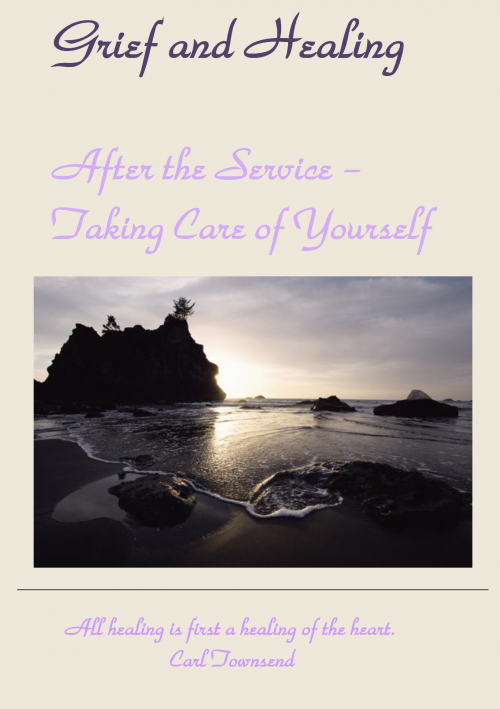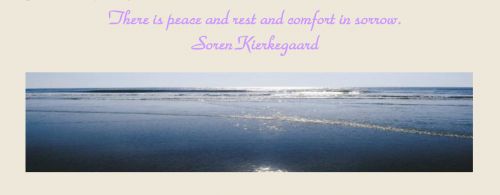
There's no way to predict how you will think, feel or act following the death of someone you cared about. Coming to a service or celebration to honor the one who died is an action that allows you to experience and express some of the thoughts and feelings you have. Often families are the recognized “mourners”. In fact, most people who attend a funeral or memorial service are grieving the loss of a person they wish had not died. Family, friends, neighbors, co-workers, social and business acquaintances, fellow students and others share a connection through the person who died and through their emotional responses to the death.
The public gathering is one thing. Your private grief is another thing. In fellowship with others, we remember the life story, the accomplishments, the challenges, the relationships, the personality and interests of the person we honor. In private, you remember the story of how that person touched your life and what the person’s death means to you. In public, people reach out to each other – talking, comforting, holding one another. Often your private grief is endured in isolation – people aren’t reaching out to you, and you aren’t seeking out others.

When people do look for help, the number one question is, “Am I normal?” – as opposed to extraordinarily emotional, weak, lacking in faith, sick or crazy. Almost without exception the answer is “Yes.” What you are experiencing, thinking, feeling and doing is normal for a person who is grieving, even though it is not like your normal, non-grieving self. While the details of your experiences are unique, the nature of what you are going through is common to the majority of people in your situation. Learning that you are grieving normally almost immediately relieves some tension and worry.

You may have heard about “stages” of grief or that grief is like a roller coaster or waves. You might know that certain emotions are typical of grieving people – emotions like guilt and anger and depression. How you grieve may or may not fit any description you have read or heard – including what you are reading now.
One emotion that seems almost synonymous with grief is sorrow. Plain old sadness. Hardly anyone loses a dear family member, friend or acquaintance without feeling sad about the death. If life seemed fuller because the person shared it with you, life seems emptier now. If you enjoyed having the person in your life, life seems less joyful now. If your hopes included a shared future, life seems less hopeful now. A natural emotional response is sadness, a soft and sorrowful yearning for a different reality you know is not possible. When you are feeling that sorrow, you are probably feeling the purest expression of your grief.

There’s a kind of helplessness that may come with grief. You are facing a problem without a solution. Someone you love has died and there’s no way to undo that circumstance. Many people look forward to a spiritual reunion or feel an ongoing spiritual connection and that is important. It is not the same as sharing life, day to day, with a living, flesh-and-blood person. In that helplessness lies the inclination to endure grief silently and alone, acting like it doesn’t hurt or like you’re handling it better than you are. Eventually you may become used to the feelings of loss, or numb to them, and think that time has healed you. Sadly, people end up carrying around great weights of accumulated sadness that they thought was behind them just because time had passed. That baggage can result in weariness, a lack of enthusiasm or hope, emotional and relationship problems, even physical health problems.
If you find that your thoughts, emotions and actions are troubling you, interfering with your life and sense of well-being, you can do something about it. The decision to try to get better is very often the point at which helplessness dissolves and improvement begins. Just imagining that there might be life after the intensity of your grief can be a tremendous relief. The alternative is the expectation that you may feel this way for the rest of your life – and most people would rather not have to endure that.
Grief is normal and natural. Grief goes with loving. When you love someone, you hurt when that person dies. In a way, it is a cost of loving. Sometimes people wonder, when they are stricken with the deepest pain of loss, if it was a mistake to love so much. When asked, “Would you have had it any other way?” the answer is always, “No!”

Since you have read this far, you probably are affected by grief deeply enough to want to do something about it. What might you do that would help you go through this time of grieving?
Here are a few ideas that have proven helpful to many people:
*Use your resources. Reach out for support from family, friends, members of your faith community - anyone who is part of your network of relationships. If you have established patterns, routines or rituals of spiritual, emotional and physical health, use them to deal with the current state of your life. Praying, journaling, working out and other activities can be valuable aids to both endurance and healing when you are grieving.
*Find new resources. There are all kinds of printed materials to provide information, inspiration and direction that can help grieving people. Ask around, visit a bookstore or library, go online. Look for titles and descriptions that speak to you. There are many grief-related connections online, including websites, articles, chats and blogs, as well as links to local support providers.
*Seek community or professional support. Hospices, funeral homes, churches and other organizations provide support groups, informational meetings, classes and counseling for grievers. Grief counselors, mental health therapists, pastors, chaplains and others can provide individual help as you work through your grief experiences.
The love you shared proves that you are lovable. Now it’s time to love yourself enough to take care of yourself in your grief.

Download a Printable PDF here

